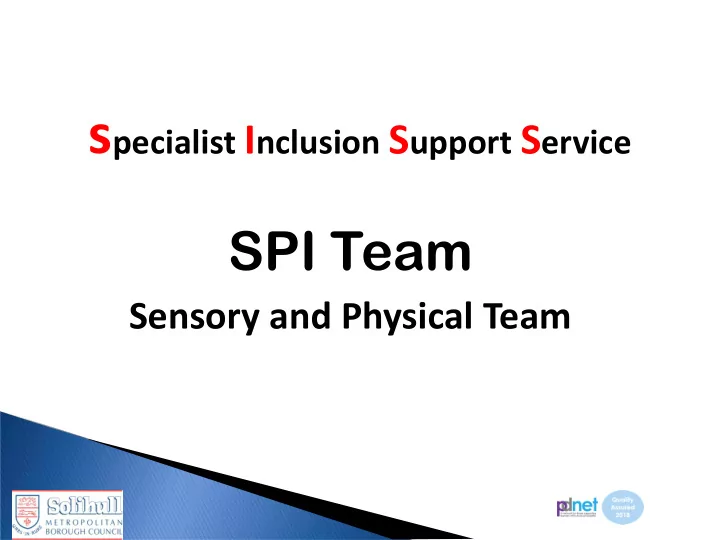

s pecialist I nclusion S upport S ervice SPI Team Sensory and Physical Team
Duchenne henne Muscul cular ar Dy Dystr strophy (DM (DMD) D)
Aims Of The Training To give a brief overview of DMD To consider the key issues for the condition To provide some strategies to enable access to the school day and the curriculum To signpost to further information
Brie ief O Overvie iew o of Duche henne nne Muscu scular ar D Dyst strophy • Genetic condition - only affects boys. • Causes progressive muscle weakness due to a lack of a muscle protein called dystrophin. • Occurs in about 30 boys per 100,000 but there may be more than one member in a family affected. • Aged around 8 to 11 the weakness often progresses to need to use electric wheel chair. • DMD is serious and severe enough to limit life expectancy.
Phy Physical Si Signs in n Ear Early Yea ears As the condition progresses boys with DMD are unable to walk as fast or far as • other children and use a waddling gait • Calf muscles become enlarged as the boys walk on tiptoes to compensate for the pelvic weakness. Don’t discourage tip-toeing as they are often unable to maintain an upright posture with feet flat. • Rising and lowering from and to the floor becomes difficult. (Gower’s Sign) • 'pupil'will struggle to climb stairs and need handrail support. • 'pupil'is not able to jump and will fall more than others. • 'pupil'may have difficulty using some of the play equipment as well as problems getting on and off and in and out.
Early Years for children with Motor Difficulties
Physiothe therapy/ Occupa upati tiona onal Therapy A Advice • Encourage sitting down and standing up independently. A chair may be needed –supported by adult. • Allow 'pupil'to adopt a suitable position for sitting – provide sturdy furniture to lean against if required. Do not rush 'pupil'in these actions. • Avoid activities and games where repeated standing up and sitting down is expected. • Do not pick 'pupil'up under the arms as the muscle weakness means that the shoulder joints are particularly vulnerable. • Take care that 'pupil'is not over-exerted as this can have a detrimental effect on the muscle wasting process.
Inc ncludi ding ng Pupi Pupil -Top T op Tips ps • Encourage 'pupil'to participate in activities as much as able – “window of opportunity.” • 'pupil'needs to be encouraged and given time to follow usual rules and routines. • 'pupil'needs TIME and space to move and be able to finish activities. • Look out for tripping hazards. • Allow 'pupil'to adopt most comfortable position for activities – condition means that 'pupil'experiences pain/cramps in his arms and legs. • Watch out for fatigue and factor in rest breaks
Developing/Maintaining gross Motor Skills – Outdoor classroom Core stability (hips, trunk, shoulder & neck) Ability to cross midline smoothly Stability, flexibility and strength at elbows wrist and hand
Fine Motor Skills Activities to promote tripod grip
Promote position to allow children to best access activities in the Early Years High kneeling standing Long sitting Tummy lying The physiotherapist would advise on best position Observe and respond –physical difficulties will change… it is never job done!!!
What t does es good od seating ng look like ? • Hips, knees and ankles are at 90 degrees (hips can be a bit higher than the knees if this is more comfortable and the feet supported) • Appropriate seat depth so bottom is at the back of the chair and thighs fully supported. Front of the seat is not digging into the back of the knees. • Appropriate seat height so that the feet are flat on the floor or are supported in some other way. • Forearms rest comfortably on the table, without shoulders being “hunched” • Head should be up and in midline. • Chair can be pulled fully under the desk. Seating in this way means that hands can be used to the best effect.
Good sitting position
Usef eful ul strategies es • Simplify language - break down instructions – start off with single instructions. • Allow time to process before repeating the same phrase. • Give visual cues, avoid reliance on verbal memory. • Gain attention before giving instruction. Encourage 'pupil'to repeat instruction. • Praise effort – good trying.
Toile letin ing • It is important to maintain dignity and discretion with regards to toileting. • Lever taps - enable independence. • 'pupil'needs to feel safe on the toilet – consider toilet frame • Toilet needs will need to be re-assessed regularly due to progressive nature of DMD. • Seek specialist advice from Occupational Therapy as needed.
Outd tdoo oors • Additional support may be required for some outside activities. • Care should be taken to minimise the risk of being knocked over. • Encourage safe strategies for getting on/in equipment. • When playing on trikes, care should be taken to eliminate the risk of colliding with others. • Specific advice for regarding outdoor climbing equipment should be sought .
DM DMD and nd La Lang nguage Di Difficulties • Listening and processing information • Auditory memory difficulties • Phonological processing • Articulation • Language delay BUT important to develop the vocabulary • Build on strengths to alleviate frustrations
Wh What wi will you take fr from this? • Some understanding of DMD • Time and space • Good seating • Positives – “window of opportunity”
Recommend
More recommend